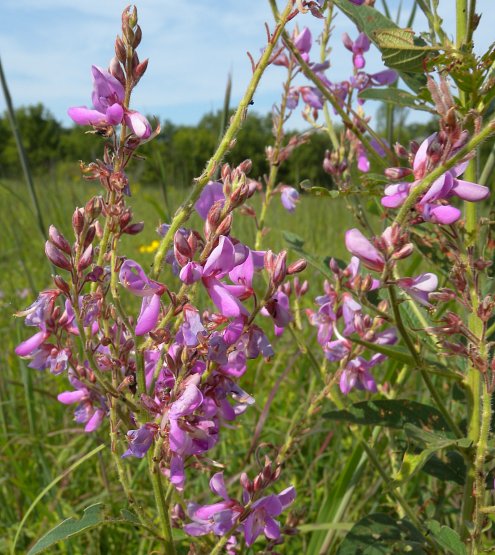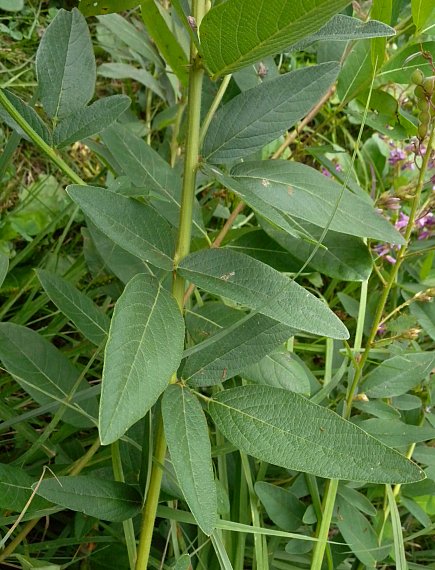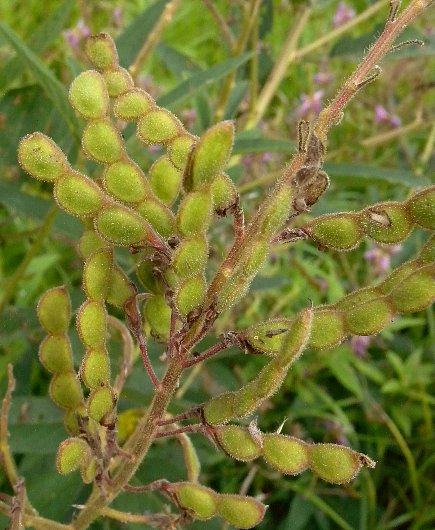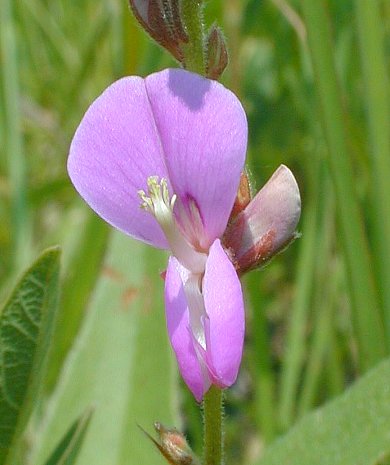Description: This herbaceous perennial plant is about 3' tall and normally erect, although it sometimes sprawls along the ground. The green central stem has fine white hairs, sometimes turning brown in response to drought. There are usually a few flowering side stems in the upper half of a large mature plant. The compound leaves consist of three leaflets that are greyish green. Each compound leaf has a short petiole with a pair of small deciduous sheaths at its base. The leaflets are 2-3½" long and less than half as wide. They are oblong or lanceolate in overall shape, but rounded at the tips rather than pointed. Their undersides have fine hooked hairs that cling to clothing or the fur of passing animals.

Numerous pink flowers in an elongated panicle occur at the end of one or more of the upper stems. The flowers are about ½" across (as measured vertically), consisting of an upper and a lower petal. These petals are initially folded and keel-like, but eventually open wide, begining with the upper petal. There is a small patch of dark pink at the center of the flower, from which emerges an upwardly curved white tube containing the stigmas and pistil. There is no floral scent. Each flower occurs on a hairy red pedicel, and has a hairy greenish red calyx.The blooming period occurs during mid-summer and lasts about 3 weeks. The flat seedpods have 3 to 5 segments and are about 2½" long. Like the undersides of the leaves, they are covered with fine hooked hairs, and are distributed by passing animals. Usually, the lower side of a seedpod is more rounded than the upper side. Technically, these seedpods are called 'loments.' The root system consists of a taproot that is long, slender, and brown./p>

Cultivation:
The preference is full or partial sun, and moist to mesic conditions. A
loamy soil with some organic matter is quite satisfactory. The foliage
is often discolored by powdery mildew. This plant increases the
nitrogen content of the soil by means of root nodules.
Range
& Habitat:
The native Showy Tick Trefoil occurs occasionally in most counties of
central and
northern Illinois, but is it uncommon or absent in southern Illinois
(see Distribution
Map). Habitats include moist to mesic black soil prairies,
moist meadows along rivers, borders of lakes, thickets, limestone
glades, and areas along railroads where prairie remnants occur.

Faunal Associations: The most important visitors of the flowers are long-tongued bees, including bumblebees, Melissodes spp. (long-horned bees), and Megachile spp. (leaf-cutting bees). Only pollen is available as a floral reward (Robertson, 1929). Other insects feed on the foliage, seeds, and other parts of Showy Tick Trefoil and other Desmodium spp. (tick trefoils). These species include the seed-eating larvae of such weevils as Apion decoloratum and Apion reconditum, Odontota horni (Soybean Leafminer) and other leaf beetles, larvae of such gall flies as Choristoneura hamata and Neolasioptera desmodii, the aphids Microparsus desmodiorum and Microparsus olivei, the seed-eating Megalotomus quinquespinosus (Lupine Bug), leaf-eating larvae of Atomacera debilis (an Argid sawfly), leaf-mining larvae of such moths as Parectopa lespedezaefoliella and Porphyrosela desmodiella, leaf-eating larvae of such skippers as Thorybes bathyllus (Southern Cloudywing) and Thorybes pylades (Northern Cloudywing), larvae of two butterflies, Everes comyntas (Eastern Tailed Blue) and Strymon melinus (Gray Hairstreak), and Neohydatathrips desmodianus (Tick Trefoil Thrips). The flowering stems of Showy Tick Trefoil are a preferred food source of Popillia japonica (Japanese Beetle), which can weaken this plant sufficiently to interfere with the formation of seedpods. For a more complete list of these insect feeders, see the Insect Table. Like many other members of the Bean family, this plant is highly edible to various mammalian herbivores, including deer, rabbits, groundhogs, and livestock. Some upland gamebirds and small rodents eat the seeds, including the Bobwhite Quail, Wild Turkey, White-Footed Mouse, and Woodland Deer Mouse (Martin et al., 1951/1961; Hamilton, 1941). The seedpods can cling to the fur of mammals and clothing of humans, causing this plant to spread into new areas.

Photographic
Location:
Photographs were taken at Meadowbrook Park in Urbana, Illinois.
Comments:
This is one of the showier Tick Trefoils because of the plentiful
flowers, assuming it isn't marred by insects and disease. Showy Tick
Trefoil is more attractive when it occurs in colonies, rather than as
isolated plants. Distinguishing the different Desmodium spp.
is rather difficult. Important features to consider are the number of
segments and shape of the loments, and the size and structure of the
compound leaves. Showy Tick Trefoil can be distinguished from Desmodium
illinoense (Illinois Tick Trefoil) by examining the base of
the compound leaves. The leaf-stem (primary petiole) connecting the
compound leaf to the stem is much shorter in the former species than
the latter species. Similarly, the leafy bracts at the base of the
leaf-stem are smaller and more deciduous in the former species than the
latter species.